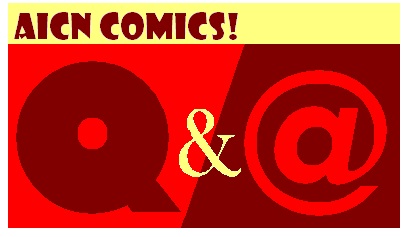
@’s by Monsterverse’s
Kerry Gammill and Sam Park!!!
For those of you not in the know, Monsterverse is the comic book company behind two of the best horror books out there right now…BELA LUGOSI’S TALES FROM THE GRAVE and FLESH AND BLOOD! Mr. Gammill and Mr. Park were nice enough to sit down and Skype with me about all things horror and comic related as well as their plans, present and future, for the company known as Monsterverse!!!
This interview is a transcription of an actual audio interview that I’ll be posting on my own podcast at www.parttimefanboy.com, but for now you can enjoy it here in all its glory!
 Well, let me first say, I mean, starting off that way, I’m a big fan of your work, Kerry, so I’ve been…I mean, I said it at Comic-Con and I’ll say it now. I mean, your Superman stuff was just…I loved it so I told that to Neil (Vokes) too and it’s gonna sound like I’m repeating myself with you, but I loved the Superman stuff.
Well, let me first say, I mean, starting off that way, I’m a big fan of your work, Kerry, so I’ve been…I mean, I said it at Comic-Con and I’ll say it now. I mean, your Superman stuff was just…I loved it so I told that to Neil (Vokes) too and it’s gonna sound like I’m repeating myself with you, but I loved the Superman stuff.KERRY GAMMILL (KG): Well, you can repeat yourself all you want.
Yeah, no, just to say. I mean, I was a big John Byrne-head when that…when he did the re-vamp and stuff. And then…I was gonna drop the book and then you came on and I was like, “Hey, wait a minute…I can’t drop this book! This is great stuff!” So, yeah, I loved it.
SAM PARK (SP): If I can throw a little story in, when I was four years old and visiting Kerry in Texas, he’s my cousin, so I showed up…
KG: He just showed up at the door, a four year old kid.
SP: He had pads that you do your big “A” and little “a” and big “B”, you know, work out your letters. Here he was six years old doing this. So I’m fascinated by that, I’m flipping through it, and suddenly I flip a page over and there is Superman and I don’t mean Superman from the comics, I mean it’s Superman from the George Reeves TV series in color crayon and to this day I’m still stunned by the fact that…you know how a crayon leaves a big thick mark? Well, Kerry had filed down the crayons or something and had…it was just beautiful. It was done like it was, you know, colored pencil or something. And that’s when I realized that my cousin was a super talented artist.
superhero: That’s great. That’s a great story. So you guys are cousins?
KG: Mmhm.
superhero: You’re related. So who’s older? Who’s younger? How does that…?
SP: Kerry’s about twenty years older than me. (Laughter)
KG: Yeah. I’m two years older.
superhero: Oh, ok.
KG: Our mothers are sisters.
superhero: Gotcha. Gotcha. And so, Kerry, you’ve always been drawing since you were little?
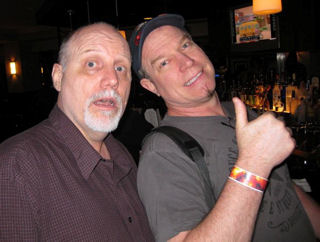 KG: Yeah, and Superman is really the first thing I can consciously remember drawing because I was so, you know, enthralled by that TV show when I was a kid, that George Reeves series. That was Superman to me. I’d started out with that shot of him standing there with the flag behind him and everything. That’s the way I always used to draw him when I was a kid, with the hands on the waist like that. So I’m sure that must’ve been the version that Sam saw.
KG: Yeah, and Superman is really the first thing I can consciously remember drawing because I was so, you know, enthralled by that TV show when I was a kid, that George Reeves series. That was Superman to me. I’d started out with that shot of him standing there with the flag behind him and everything. That’s the way I always used to draw him when I was a kid, with the hands on the waist like that. So I’m sure that must’ve been the version that Sam saw.superhero: That’s great. And so it sounds like you guys have been close ever since you have been young. Because I know that you dedicated one of your books to Sam because he told me that story at Comic-Con.
KG: Well, we both had the same interests. He was my only relative that was…well, my brother and I at that time when he was young he liked monster films a lot. But he was never into comic books or anything. Sam and I were more compatible with comics and sci-fi and horror movies. We loved the old serials, Republic serials, and all those action movies, Tarzan films and all that stuff. So it was just cool when we would get together that we had so many interests in common. And when Sam was older, we got to be in high school and stuff, he would come to visit us for two weeks or so every summer. Sometimes a week, sometimes two weeks, and that was always something we looked forward to. We just really got to know each other really well when we were teenagers and got to be together for a little period of time more often.
SP: There’s a photo, Kerry used to have a…you’d call it a studio but it’s kinda like a sanctuary up in the attic at his dad’s and mom’s house. And in this sanctuary upstairs it was in the…literally in the attic. You had to go up through the garage and pull the ladder down and go up in it. But inside there, Kerry would do makeup effects and things, he had the Dick Smith makeup book from…that Warren magazines put out, the guys who did FAMOUS MONSTERS and the CREEPY and EERIE.
KG: My dad made us do all that kinda stuff up there so we didn’t mess up the house.
 SP: Yeah. So in this place I’d show up for these visits, and there would be a Frankenstein monster headpiece or a Phantom of the Opera or there would be a castle built out of sugar cubes and painted to look like a castle that would be a part of a Super 8 film that was going on. Plus there would be all these 8mm films from Laurel and Hardy to the Castle Frankenstein or Dracula, all the Universal stuff. And so we’d show up and here we were these kids that loved these movies and imagination and we would film stuff, we would draw, we would go over through all the books. There’s a great photo that Uncle Bill took, he popped up the ladder, and Kerry’s leaning towards me from a chair and I’m on this bed they kept up there and I’ve got all these Creepy and Eerie magazines opened up already to certain stories so we could both go over it and discuss them one by one. It was all set up, I was ready, let’s go. Because every second I was visiting there, I wanted to make good with it. And, in fact, the LA Times ran that photo. Geoff Boucher ran that on an article for our Rick Baker cover for the second issue. So anyway, I’ll see about getting you of those just so you can see what it looks like. We’ve always been into this.
SP: Yeah. So in this place I’d show up for these visits, and there would be a Frankenstein monster headpiece or a Phantom of the Opera or there would be a castle built out of sugar cubes and painted to look like a castle that would be a part of a Super 8 film that was going on. Plus there would be all these 8mm films from Laurel and Hardy to the Castle Frankenstein or Dracula, all the Universal stuff. And so we’d show up and here we were these kids that loved these movies and imagination and we would film stuff, we would draw, we would go over through all the books. There’s a great photo that Uncle Bill took, he popped up the ladder, and Kerry’s leaning towards me from a chair and I’m on this bed they kept up there and I’ve got all these Creepy and Eerie magazines opened up already to certain stories so we could both go over it and discuss them one by one. It was all set up, I was ready, let’s go. Because every second I was visiting there, I wanted to make good with it. And, in fact, the LA Times ran that photo. Geoff Boucher ran that on an article for our Rick Baker cover for the second issue. So anyway, I’ll see about getting you of those just so you can see what it looks like. We’ve always been into this.superhero: So I know a little bit about Kerry’s history, but Sam, were you always working in comics or writing? I know you’ve done some of the writing on Tales from the Grave.
SP: Well, I had an interesting history. I went to college a year, then got out and worked for four years. A part of that I went down…I’m from Missouri, I went to Fort Worth and worked with Kerry on a TV show that showed old horror movies, it was called “Museum of Horrors”. I’d host, Kerry would work with the guy and played the sidekick Ygor, and we would do live shows like at Six Flags but also do this every weekend was some, y’know, movie and we would film an opening and little skits between and after and other things. And then I finally went back to school, got a degree, and taught, and I went down to Texas to Houston where I taught school and then got involved with guys there and we put on the biggest comic conventions in Texas at that time. We kinda came up and some other guys have gone out. So we started doing that, and they were very successful. That’s how I first got to meet and know a lot of people in comics very well. Plus, when your cousin is Kerry Gammill who is drawing, I believe you were doing MARVEL TWO IN ONE at that time. Right cuz?
KG: Team Up. Yeah. MARVEL TWO IN ONE.
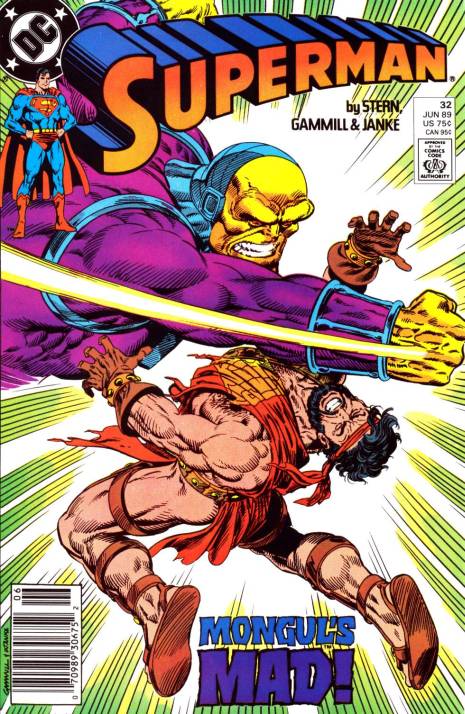 SP: So, you know, Kerry was a big shot in Texas because he was one of the few guys that was really working for the big Marvel at the time. And then in would come all these people and so I got to know all these guys really well and, of course, because Kerry and I have this background, I became good friends with a lot of these guys because I could speak their language. We’d really get into talking about movies or comics and things and I’m very lucky. Over the years, friends I’ve made from Frank Miller to Paul Gulacy and all these kinda guys that we just know them on a personal level. For loving the same…we could sit and talk about other people’s comics. It’s great to talk with Frank and sit down and talk about whatever, but then to hear him wax eloquently about how much he loved the Legion of Superheroes as written by Jim Shooter. You know?
SP: So, you know, Kerry was a big shot in Texas because he was one of the few guys that was really working for the big Marvel at the time. And then in would come all these people and so I got to know all these guys really well and, of course, because Kerry and I have this background, I became good friends with a lot of these guys because I could speak their language. We’d really get into talking about movies or comics and things and I’m very lucky. Over the years, friends I’ve made from Frank Miller to Paul Gulacy and all these kinda guys that we just know them on a personal level. For loving the same…we could sit and talk about other people’s comics. It’s great to talk with Frank and sit down and talk about whatever, but then to hear him wax eloquently about how much he loved the Legion of Superheroes as written by Jim Shooter. You know?And all these things and, you know…so I’ve been very fortunate in having that and then Kerry and I have done this our whole life. I mean, we’ve analyzed comics, movies, books, TV shows, you name it, and broke it down and how it was perfect or not so perfect. But if they used this scene from this movie and put it in…oh, yeah, yeah! Or they did the makeup like this and added that. You know? So we’ve been kinda gearing up our whole lives, Kerry working in comics, I came eventually to LA and began to write screenplays and I got known for that. I’ve not got a big, major thing made yet but I used to be in a writer’s group with eleven of us. There was David Goyer, Peter Lenkof put it on. It was at Universal. We met every two weeks on Thursdays in the Jack Webb room, I always remember that, and we had Mark Verheiden was in the group, Robert Hewitt Wolf, went on to do a lot of Star Trek things, David Simkins, who at that time, I believe, was working on BRISCO COUNTY JUNIOR.
superhero: Oh yeah, BRISCO COUNTY.
SP: And then, you know, everybody’s gone on to do a whole bunch of different things. I’ve gone on to write a lot of things, I get in here and there, and I’ve produced a couple of low budget movies, nothing major mind you. But eventually Kerry then came around with technology today, comic books and things…I mean, computers and everything, and he so wanted to do the horror book and that led to Monsterverse, which I’ll let Kerry tell you.
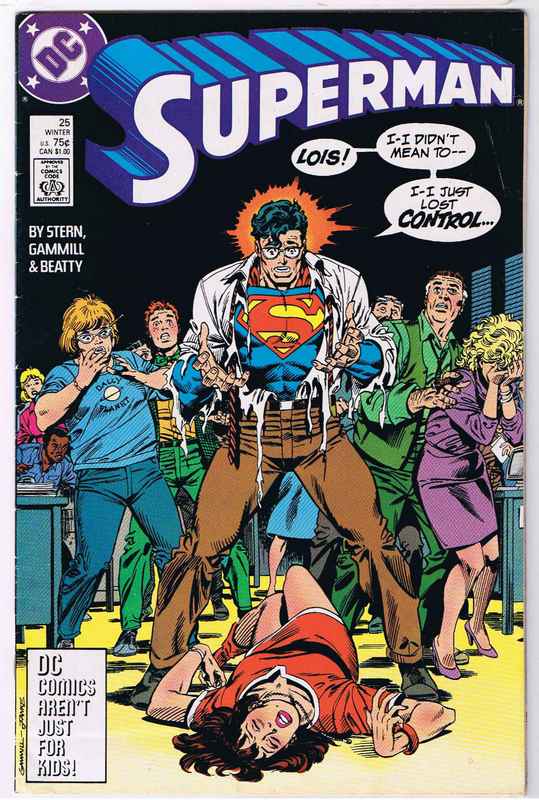 superhero: Yeah, so, I mean, going back just a little bit, Kerry, so were you always just wanting to start in horror? Or was it superheroes? Because, I think, Kerry, you got started off in superhero comics. Correct?
superhero: Yeah, so, I mean, going back just a little bit, Kerry, so were you always just wanting to start in horror? Or was it superheroes? Because, I think, Kerry, you got started off in superhero comics. Correct?KG: Yeah, well my first love was always monsters from the time I was real small when they had a show on Saturday nights on our local station called “Nightmare” and one of the original horror hosts, a guy named Gorgon, and luckily it came on early enough. Most of the country, you know, those kind of shows were on at like 10:00p.m. or 1:00 a.m. on Saturday nights. And ours was on I think at 8:00 p.m. and so I could see all these things, all the Frankenstein, Wolfman, Dracula type films. And I just lived for those. Every weekend it was the highlight of my life, just waiting for those horror films. And I was just fascinated with those monster characters and just those periods, the 30s and 40s, they just had such a magic quality to those movies. But then I got into Marvel comics in the late 60s. I read a few comic books when I was younger--I’d buy things like Superman and Batman--but the DC stuff just never really grabbed onto me that much. I think Superman I didn’t like much because I was so ingrained with the TV show, that image of him, that it didn’t seem like the same character. And so I didn’t get too many of those. But then it was when the Spider-Man TV show came on, it was ’67 I guess, that they had…
SP: The animated show, by the way.
KG: Saturday morning cartoon series. Where that famous theme song came from. And I just thought that was so cool, that guy swinging around on a web. And even you look at that cartoon now, it’s not very well made and they…but, you know, it had a certain amount of the character that they captured, just that essence of him crawling walls and swinging webs and stuff. And a friend of mine in junior high at the time, I told him about watching the Spider-Man show, goes, “Well, you should read the comic books if you like the TV show.” And it turned out he was a closet comic book reader. He’d been one of my best friends since we were 12, and he’d never told me that he read comics because he was embarrassed. So I’d go over to his house and he’d pull out his Spider-Man. That’s when I got into superheroes.
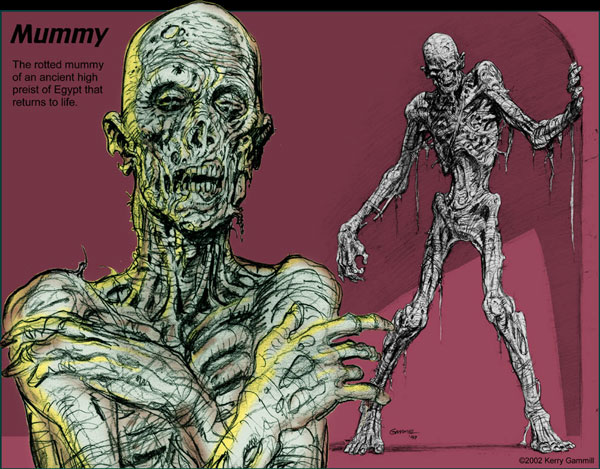 SP: But Kerry, comics…and I remember this, it was the Warren magazines, they had…Kerry had a subscription to Famous Monsters and then, of course, when they announced the Warren books, Kerry and them had subscriptions to that. And I remember when I’d visit, Kerry would have drawings on notebook lined paper or in a big pad and it was all monsters and it was based on the film stuff. And then, of course, Warren magazine things if there was something interesting out of all that. And then slowly the superhero stuff began to work its way in there. Ditko was something we’ve all been fascinated with both in the Warren books and his Spider-Man stuff. And Kerry, I remember, would do some great illustrations of that. And, by the way, the Warner Brothers Looney Toon cartoons, Kerry used to draw these cartoony characters all the time. People have never really seen that from him, but I think he was definitely, you can tell, influenced by the Warner Brothers stuff. The caricatures.
SP: But Kerry, comics…and I remember this, it was the Warren magazines, they had…Kerry had a subscription to Famous Monsters and then, of course, when they announced the Warren books, Kerry and them had subscriptions to that. And I remember when I’d visit, Kerry would have drawings on notebook lined paper or in a big pad and it was all monsters and it was based on the film stuff. And then, of course, Warren magazine things if there was something interesting out of all that. And then slowly the superhero stuff began to work its way in there. Ditko was something we’ve all been fascinated with both in the Warren books and his Spider-Man stuff. And Kerry, I remember, would do some great illustrations of that. And, by the way, the Warner Brothers Looney Toon cartoons, Kerry used to draw these cartoony characters all the time. People have never really seen that from him, but I think he was definitely, you can tell, influenced by the Warner Brothers stuff. The caricatures.superhero: That’s cool--so then you have a career in comics and then you go on to creature design. Right? In movies and stuff like that?
KG: Yeah, in the late 90s there was a friend of mine who worked in special effects. He sent me an ad that had been in one of the trade things for a concept artist and it said in the ad that you could work by fax or something. So I was living in Texas so I sent in some samples and was interested in the job. But then it turned out that it was for Steve Johnson’s…Ex Effects was the name of the company. Steve used to be one of Rick Baker’s crew back when he was doing AMERICAN WEREWOLF IN LONDON and that stuff, and then went out on his own later and did movies like SPECIES and all the Steven King miniseries that have been on. He’s done the makeup for those. So…but after I sent the stuff in he called me and said he liked the stuff, but he wanted to know if I could come out there and work. Well, I wasn’t really planning on relocating. But they had just gotten some big movie job and they said, “Well, can you come out for a couple of months and work on this one movie?” I thought, “Well that sounds cool. I’ll have a little adventure out there.” And the movie turned out to be terrible, it was VIRUS with Jamie Lee Curtis.
But they thought it was gonna be a big blockbuster and put all this money into it and everything. So I worked on that for a long time, but then once I was out there, I just kept working on more and more stuff for him and decided to stay. So I was out there for a couple of years working for Steve and then I got offered an art director job at an agency that was just starting up in Dallas. Some of the guys I used to work for were involved in that. So I ended up moving back because it was just too much money to pass up. And my family was still back here, I was just going back and forth every few weeks. And so it’s kind of an odd couple of years there. But even when I was back, I did a little work for K&B Insects and ADI and a few others. So I haven’t done much recently, but I’d like to get back into that because that was really fun. It was, like, the coolest job.
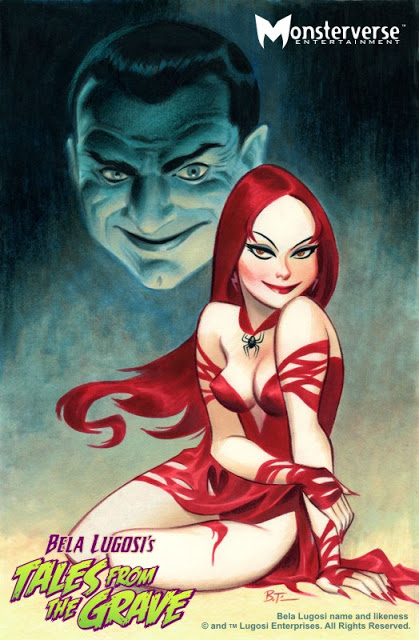 superhero: Have you guys stayed involved in comics through all that? Interested in comics? Or did you kind of drop out and then get back in? How did that sort of thing work?
superhero: Have you guys stayed involved in comics through all that? Interested in comics? Or did you kind of drop out and then get back in? How did that sort of thing work?KG: I lost my interest in it because I just started feeling out of touch with the readers. The younger the readers got and the older I got, there started to be this gap there, which I realized after I tried to come back and do some work at Marvel after I’d been at DC for about 5 years doing most of my work over there. And it was…so much had changed in those few years that I just didn’t feel like I knew the characters anymore. All those Image guys had come up. McFarland was doing Spider-Man and all these X-Men books out the wazoo and everything. It just had become so commercial and the books were selling so much at that time that they didn’t really care what you drew even. It was just like fill up these pages and we’ll print it and they’ll buy it and don’t worry about it. You know? I was like, “Well, I wanna get a handle on this character.” I just never could feel at home with it anymore.
And so that’s when I started getting fewer and fewer jobs, just things… and then the bottom dropped out of everything which is why it got so bad. Because they had the big implosion or whatever of the late 90’s that…I had a friend who owned two comic book shops and within a two month period, his business went down 75%. Like, overnight. The comics had gotten kinda married to the card collecting hobby. You know? And that’s when all the stuff started coming out, the previews and Wizard World and all that. And everybody would buy the…
SP: And all the variant covers and the tinfoil and all that stuff.
superhero: Which is sort of back now. So what is it about the comics market now that you guys have formed Monsterverse and are putting out Tales from the Grave? What has changed that you guys are getting back into the market?
KG: Because we’re doing what we wanna do. Like Sam was saying about the Warren stuff, you know, Creepy magazine and Eerie and then later VAMPIRELLA, those were my first real comics that I got involved in and they were exactly what we’re doing now, short six or eight page horror stories with some twist ending or funny shock thing at the end. Which I thought they had invented; Archie Goodwin was writing most of them and he was just brilliant the way he could pull those things off. But I didn’t realize that, you know, Tales from the Crypt and all those EC books had been around in the 50’s. There was nothing like that on the stands at that time because that was in the middle of the comics code thing, so regular comics couldn’t have any gruesome or horror type things. But the Warren stuff wasn’t…they didn’t have to submit to the comics code because they weren’t comic books, they were magazines. And…but there were such great people there, because he could’ve gotten the cream of the crop from the old DC days. So he had Williamson and Torres, Jack Davis, Reed Crandall.
 SP: In every issue there for a while was Frank Frazetta painting your covers! Can you imagine that? It was an incredible period. In fact, I think it’s a period that needs to be revisited and looked at a little closer because it is so important. Also, it was a great alternative for…I mean, think about it. Steve Ditko would draw Spider-Man and these things and then turn around and do these incredible stories with Archie Goodwin writing them at Warren and it was a larger format, the magazine was bigger than a comic, and had less restrictions, and you had Neal Adams.
SP: In every issue there for a while was Frank Frazetta painting your covers! Can you imagine that? It was an incredible period. In fact, I think it’s a period that needs to be revisited and looked at a little closer because it is so important. Also, it was a great alternative for…I mean, think about it. Steve Ditko would draw Spider-Man and these things and then turn around and do these incredible stories with Archie Goodwin writing them at Warren and it was a larger format, the magazine was bigger than a comic, and had less restrictions, and you had Neal Adams.Oh, and the reproduction was better than the color comics. So someone like Neal Adams, who had a sharp, Madison Avenue advertising look to his inks and line work and all that, could do work for them. And then you had all these EC comic guys who they were tremendous at EC, but it’s 10 years later and they too had done Mad Magazine and advertising and all that. So Warren really offered a great place for these guys to do stories, and I really feel like the Warren magazines, in many ways, are better than the EC books, though I love the EC and a lot of things. But I just felt like EC could be a little too text heavy and crowd the art a lot.
KG: It’s much more polished by the time they were doing the Warren.
SP: Yeah, and I think Archie Goodwin was very much more open to allow the artist to tell the story and pull back on the narration. You know? And just let it be minimal and all that. I mean, Archie Goodwin’s a genius. He tells stories incredibly and I don’t think you’ve ever seen anybody that worked as a writer or artist under Archie as an editor have anything but, you know, their love for the man. You know? And I think that shows in everything that he does and those books were that good--they were so good. So here’s Kerry calling me up later and saying he’s putting together this company Monsterverse and, you know, I started out just kinda getting in there and he was bouncing stories and stuff off of me that they were considering and all that. And the next thing I know it’s like, “Well, hey. You wanna be a part of this?” And that’s how Monsterverse sort of came about was…
superhero: Yeah, what sets off the spark though? Because, I mean, you’d been…had you been out of comics for a while? And was it just something at some point where you said, “I’m gonna do this! Forget it! I wanna do my own thing and I’m just gonna go forward with it!” Did anything specifically set it off or had it just been gestating?
KG: I wasn’t doing anything else! There was a period there that I had been doing a lot of work for the local ad agencies and they were promotion agencies. They were pitching stuff for kids meals and premiums and a lot of stuff for Toys R Us. And so they needed a lot of concept art done, quick sketches of things that they could bring into meetings and say, “How about this one? No? How about this one?” And so you’re doing a lot of stuff, almost none of it got produced into real items. And it was just sort of kind of dragging on me. I’d been out of comics for a long…what I missed about the comics was it’s like you’re in show biz. You know? Your name is on the stuff, you had some creative control over it and input into it, and you’re doing stuff that’s fun to read.
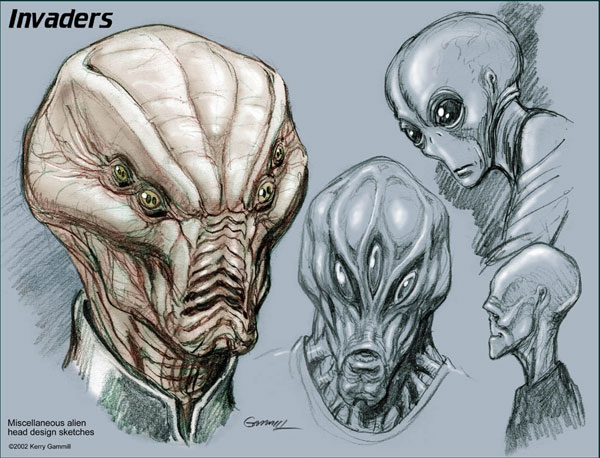 It’s not just a business thing. And the promotion agency stuff, you know, you’re just a necessary evil to them, somebody…the salesman needs some art to show and make his big sale, and so they need someone that can draw the ideas up and I would help with concepting and stuff too. But it was just nothing that I had any passion about; it was just for the money.
It’s not just a business thing. And the promotion agency stuff, you know, you’re just a necessary evil to them, somebody…the salesman needs some art to show and make his big sale, and so they need someone that can draw the ideas up and I would help with concepting and stuff too. But it was just nothing that I had any passion about; it was just for the money.SP: One thing I’d like to bring up is while Kerry was working in advertising and then also in the makeup effects before that in the 90’s, computers had really begun to alter and change and people were relying on them more and more for graphic…graphic possibilities as programs and things changed. Kerry got involved with that and got a lot of experience working in advertising and by the time things changed, like he’s saying, he also realized, as he explained to me, is that “you know, you don’t need an army of people to do a comic book anymore. You don’t need to hire a guy to letter and a guy to ink in the way that the old fashioned here’s the page and pass it down the line on paper.” Electronically and email and he’d been doing that with designing things for all these guys, it was like, “Gee, I think we can do this.” I mean, really, that’s how it was. So hey, kids, let’s put on a show! So it was Kerry saying let’s put on a Monsterverse comic.
KG: And the best thing about working with the agencies was that I got a lot of computer skills built up out of that. Because it was just…around the time I started that job was when the computer stuff was really catching on. Everybody was doing email and just the computer was a common thing to have all of a sudden. For God’s sake, me and Sam that grew up without the internet, it’s like a weird thing to think about that people have computers in their home and the little monitor and type stuff all day long to everybody. But anyway, it just happened to coincide with when computers started becoming a part of every kind of graphic system like that, that I was in a position where I could learn all about Photoshop and Illustrator and that stuff. And I had done a website that I started just for the fun of it called Monster Kid Magazine and I sort of did my little tribute to the old famous monster type magazines. Because it was just fun to do the layouts and put everything together and kind of reproduce something that had been such a part of my childhood. And I just find that I enjoyed being an editor/publisher even in that little internet world.
People would…I’d get articles and stuff from people and I’d say, “Well, I wanna change this a little bit and I’ll write this introduction, I’ll put photos here and stuff.” So I just started feeling like I do enjoy this kind of editing thing and I think I’m good at it and so it came to a point where I wasn’t doing as much of the advertising work as I was, and I took a little halfhearted attempt at getting back into comics. I almost did a story for Marvel, but I just wasn’t feeling it once I got in. I was sharing a studio with Keith Wilson, a friend of both mine and Sam’s, and he was kinda in the same boat I was and we just decided “Why don’t we start a little comic book company and just do our own thing and do…” It’s basically just for the fun of it. It started out as an expensive hobby.
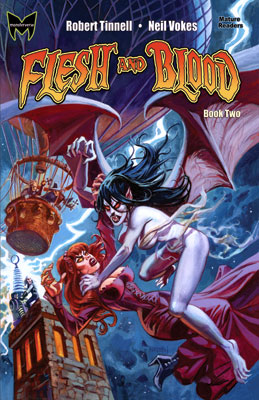 superhero: Yeah. So, I mean, can you guys talk about…a little bit about the concept behind Monsterverse in general? It seems it’s very inspired by Hammer, but the Universal horror movies. I mean, for people that don’t know behind the actual company, what is the sort of impetus behind Monsterverse itself?
superhero: Yeah. So, I mean, can you guys talk about…a little bit about the concept behind Monsterverse in general? It seems it’s very inspired by Hammer, but the Universal horror movies. I mean, for people that don’t know behind the actual company, what is the sort of impetus behind Monsterverse itself?KG: We would just love to be kind of the horror comics company. You know? There’s other companies doing horror, but there’s nobody that does exclusively horror, at least not that I’m aware of. And when we started this, at least when we had the idea to get started, there weren’t any Creepy comics. Dark Horse brought that back and then Moon Stone started publishing Vincent Price Presents comics when we were getting our comic lined up. And it’s like, “Hey, now everybody’s getting involved in this before we come out. It looks like we’re following the trend.” But we wanted to originally be the new Creepy magazine, and now Dark Horse brought Creepy back so that was a little hurdle we had to get over. But basically, we love the classic horror films and those old classic horror comics, so we wanted do stuff that’s an appreciation for the old classic stuff, but we want to keep it edgy and modern and both Sam and I, we still keep up with all the new horror films and still enjoy all those. Luckily, they’ve gotten a lot better in recent years; there was that time there that everything was just slasher films and dead teenager movies. The last ten, fifteen years though, there’ve been a lot of great, really good, clever stories and everything.
So…and of course our ultimate goal is to get some stuff that’s actually good enough to pitch as films or TV series and things like that. So that’s kind of the way we justify doing it, even though we’re not making a lot of money on the comics. It’s really…we picked the worst time to start a publishing company because sales across the board are way down. Even the highest selling Marvel and DC comics are a fraction of what they were 15 years ago. But there’s so many comics out there now, you go look at the comic shop wall and all this stuff, you go, “Man, are they really putting this many products out there?” So there’s a lot of competition and all the costs are up for printing and everything. And so it’s not something that you go into for the money. So it was just sort of a labor of love and I’ve known Bela Lugosi Jr. for several years, I would see him at these horror conventions I would go to and I ended up doing some work on some DVDs that he was coproducing where I did some things for him.
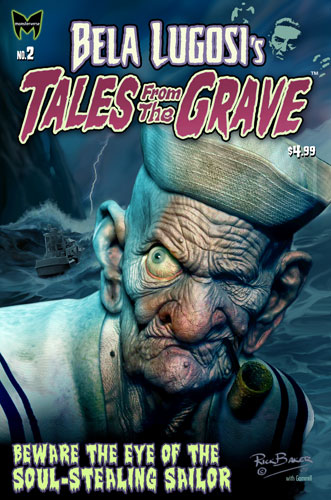 And so I kinda had the idea of doing comic books for a while. In fact, it was something that he wanted to do, he brought up doing some comic books, but he had some specific things in mind that were different from what we’re doing and I thought, “Well, if I can talk Bill Junior into letting us use his dad as our Crypt Keeper, Uncle Creepy character, that would be the coolest thing to have this Lugosi character in stories.” So that was always kind of in the plan; that was our first thing that we really had in mind to do. And it was, like I say, sort of a labor of love and stuff that we just wanted to do just to do it and because it was a passion that we had and we wanted to see it come out there.
And so I kinda had the idea of doing comic books for a while. In fact, it was something that he wanted to do, he brought up doing some comic books, but he had some specific things in mind that were different from what we’re doing and I thought, “Well, if I can talk Bill Junior into letting us use his dad as our Crypt Keeper, Uncle Creepy character, that would be the coolest thing to have this Lugosi character in stories.” So that was always kind of in the plan; that was our first thing that we really had in mind to do. And it was, like I say, sort of a labor of love and stuff that we just wanted to do just to do it and because it was a passion that we had and we wanted to see it come out there.But then we started getting more into the idea of keeping it going and expanding a line and everything and Monsterverse is what’s such a cool name. We managed to get that trademarked and everything and just lucky that no one else was doing that yet. But it sort of described what we would really wanna do ultimately if we could keep this thing going and make it successful, is just put out nothing but horror comics and very monster oriented stuff, visual things. So we’ve got ideas for a whole line of characters that if we can get certain things lined up to happen that we would like to put this whole line out there. So we would have these key characters that are in continuing series that would be a part of our Monsterverse as well as doing stuff like the Bela Lugosi series with the short stories and some other things published like Flesh and Blood, the graphic novels.
superhero: Well, I have to say, I loved the Bela Lugosi‘s Tales from the Grave and Flesh and Blood. How hard was it to convince them to let you use Bela Lugosi‘s name and just his persona for the book? Was it hard? Were you that close that he was just like, “Yeah, you can do it.” Was it his son, you said?
KG: Yes, Bela Lugosi, Jr. is now the…he’s the only son that Lugosi had and of course it was…none of his wives are alive or anything. So he controls the estate and he’s been licensing the Lugosi name and image on things for years. He’s a lawyer partly because he’s been fighting Universal legally since the mid 60s.
SP: Let’s not use the term fighting.
KG: They’ve been discussing.
SP: Negotiating with Universal for a while.
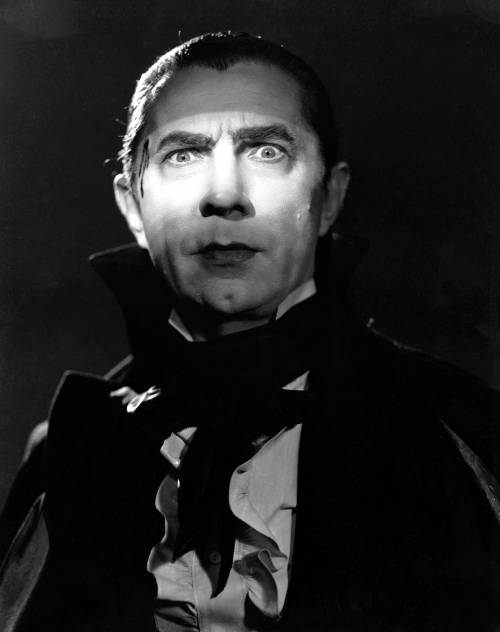 KG: Universal started marketing their monsters and they had Frankenstein, the Wolfman, Mummy, and all that, and Dracula just looked like Bela Lugosi in a cape. So Lugosi Junior was like, “Well, you’re just marketing the image of my father.” Since at that time his mother was still alive they took Universal to court and lost initially in the 60s. They were also…had masks, Dracula masks, that just looked like Bela Lugosi. So he kept going after Universal and finally things have changed so much in the last few years and now all the stars’ families from the monster films are involved with Universal and get a little part of marketing if somebody uses the Boris Karloff Frankenstein image in a commercial or on a product or something, then Sarah Karloff has to sign off on it.
KG: Universal started marketing their monsters and they had Frankenstein, the Wolfman, Mummy, and all that, and Dracula just looked like Bela Lugosi in a cape. So Lugosi Junior was like, “Well, you’re just marketing the image of my father.” Since at that time his mother was still alive they took Universal to court and lost initially in the 60s. They were also…had masks, Dracula masks, that just looked like Bela Lugosi. So he kept going after Universal and finally things have changed so much in the last few years and now all the stars’ families from the monster films are involved with Universal and get a little part of marketing if somebody uses the Boris Karloff Frankenstein image in a commercial or on a product or something, then Sarah Karloff has to sign off on it.SP: Because Kerry had worked and known the Lugosis through these conventions and different things over the years, and they realized how genuine his appreciation and love for the Lugosi films and character and all that, they got to talking and finally it just got to where Kerry got serious and Bill did too and he realized that Kerry was the guy to do it. They’re very protective of Lugosi Senior’s image and so, the whole family is, and I’d like to mention that Bela Lugosi Junior, his daughter, Lynn, works closely with him on many of these things. And so they, you know, the comic…we work up stories and do things, we present it to them, they may have thoughts and things about it and these things and, you know, not to get too gory or not to, you know, get too disturbing in some ways. But also they realize that to match the image and appeal of their father in the horror films and things, yes, they do need good stories and they need an amount of what goes into a horror story, the fear and the shock and things like that. They’re delightful people to work with. I mean, we really just like these people immensely, personally.
superhero: So, you’ve come out with two issues of Bela Lugosi. How do you select which talent you’re working with? Is it just people that you know? Do you take submissions? That sort of thing?
KG: Since it’s not a big moneymaking thing, we try to get people that just love the horror stuff and Lugosi, that kind of thing.
SP: We…we have kind of a…it goes back and forth. We have people we know real well, like, for instance, Kerry knew Basil Gogos and that’s how we got the cover for…and Kerry did the book on Basil Gogos, which Basil loved and the fans loved so much. Gogos did all the famous Monsters of Film Land covers for years and years.
superhero: Oh wow, it’s a beautiful cover.
SP: And he’s an incredible artist. Then John Cassaday, Kerry’s known him since junior high in Texas before John ever became a professional, believe it or not. And he’s a huge film nut. I mean, just…he’s really just like us in the sense that we love stories in all kinds of forms, but especially love these old classic films. And Kerry got to know John back in the…do conventions and signings at comic shops and here was this kid that could really talk and knew these things about film.
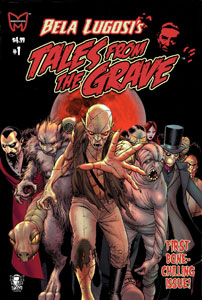 KG: Johnny didn’t live in town, he lived out in the boonies somewhere probably 20 miles away. So when his mother would be coming to town for something, he’d come along and they’d stop at the comic shop.
KG: Johnny didn’t live in town, he lived out in the boonies somewhere probably 20 miles away. So when his mother would be coming to town for something, he’d come along and they’d stop at the comic shop.SP: The point I’d like to make on this is that John will tell you today that you wanna become a good comic artist, you need to study comics and draw, learn how to draw, but nothing can beat how to…learning how to tell a story from those classic horror films. They may…some people may…I say classic horror films, classic movies from the Golden Age. Of course, films have changed and all that, and I think if you look at John’s work, especially on PLANETARY, boy, he can jump from genre to genre and change his style to suit that just amazingly. But for just really, you’re a kid or an adult and you’re trying to understand telling a story, the best of the classic, you know, Golden Age films is a huge influence on him…here’s Kerry, a huge influence on him, me, and I can tell you that, you know, all these people that we’ve known, from Frank Miller and Paul Gulacy and all these on and on, loving movies that really knew how to tell a story.
KG: John did the alternative cover just because I’ve know him for so long and he wanted to help us out.
SP: Yeah, and so here was a chance for someone like John, you know, John comes forward and says, “Yeah, sure. I’ll do a variant cover and I’ll even do a story for you.” And then, you know, here’s Bruce Timm who is a huge fan of the same kind of thing I’m describing. “Yeah, I’d love to do a…” Offered him a back, a pinup, you know, with a hot Bruce Timm girl in the back which was our Nosferina character that Kerry designed, and so on. And so people come to us, we come to them, and then we have people that surprise us that send something, you know, that goes, “Hmm. This guy actually has a really cool style or look.” Or we might find a guy on Deviant Art or something. Kerry found the guy that did the beautiful job of illustrating, and Kerry wrote the story, “Strange to the Finish”, which was inspired by Rick Baker’s Bizarro Popeye-esque cover, the character he created. And Kurt…well, Kamille and I cannot pronounce his name to save my life. Kerry, you wanna take a stab at it? Kamil’s last name?
KG: Kochanski or something.
SP: Yeah, I’m looking at it right here. But he’s a…I believe he’s a Polish or Czechoslovakian gentleman and so that’s where Kerry found… you found him. Right? Looking through stuff and contacting him?
KG: I think that’s where he came from.
superhero: So you’re basically, I mean, it’s friends, it’s people that you’ve found, and everyone’s kind of working on it through a labor of love. And so you’ve got two issues, is a third issue coming out of TALES FROM THE GRAVE?
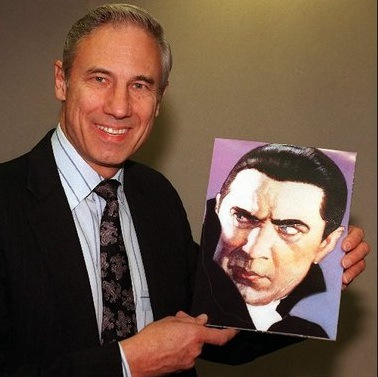 KG: We’re running way behind. I’ve had some stuff going on and, you know, I had to make some money. And we’ve been kinda bogged down in business and legal stuff. We had to get much more buttoned up with bookkeeping and setting up the corporation and everything. So that kinda stuff takes away a lot of the time it takes just to do the creative work and the production.
KG: We’re running way behind. I’ve had some stuff going on and, you know, I had to make some money. And we’ve been kinda bogged down in business and legal stuff. We had to get much more buttoned up with bookkeeping and setting up the corporation and everything. So that kinda stuff takes away a lot of the time it takes just to do the creative work and the production.superhero: Sure. And then how much…so you’ve got FLESH AND BLOOD, you’ve got Tales from the Grave--are there any other books that you’re planning? Or are you just sticking with those two for right now?
KG: We have stuff that we may be doing with some other people that, you know, they brought us this project and it looked pretty neat but we haven’t worked out the thing yet. Like I said, we have some characters that we’ve created that we’ll eventually be publishing regular series or mini series with them.
SP: We’re…I tell you, one of the things…when you start up a company like this, even as a labor of love and you’re doing it because that’s what makes you happy in creating these kind of stories—I mean, Kerry and I have gotten things in and then we would see this work that somebody had done and we’d just go, “We have to make this company a success because we love this too much.” You know? We really…and I hope that comes through with the books. I know some of the best reviews of the Lugosi book have been that, you know, they see it. They see that, “Gee, this is…”
superhero: Yeah, it’s quality. I mean, it’s serious quality. I mean, this is not…this is not some half assed self published thing. This is…
SP: Thank you, Kristian. We appreciate that. And let me say this, you know, I’m Kerry’s biggest fan and his eye for design and everything, I mean, we go back and forth on things just studying it trying to get it down to the last detail. I can tell you, the BELA LUGOSI’S TALES FROM THE GRAVE #2, he was here and we were looking at it and it had a green in TALES FROM THE GRAVE (logo) and we just kinda went back and forth and the next thing you go he worked out this sort of a mauve color. But, I mean, it was really this whole attention to try to “How do we make this perfect, as perfect as we could make it, before it goes out at the time that it goes out?” So we are very proud of the fact that people respond to the books, even if the book’s been out a year or something like that and then suddenly we’ll get an email from someone or we’ll see a review. I just put one up on the Facebook page the other day and some guy had just got around to reviewing but he was totally in love with everything about the book. And even Kerry can turn around and get Gary Rhodes, who’s one of the…a very prominent expert on Lugosi and Boris Karloff, to write the back text piece for the first issue. Or you get an interview with Rick along with getting Rick to allow us to use this image that he created in Z-Brush computer software. That’s one of the…we’re just very fortunate. Kerry is a superbly talented artist, but he’s a storyteller. And, you know, I tell you, when we go to conventions, Marv Wolfman, Mike Carlin, there’s a zillion guys that they love the books but they’re always saying, “Well, Kerry, if you ever wanna do a story for us.”
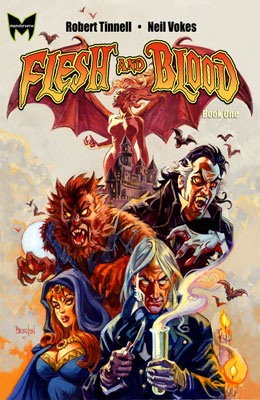 I mean, I hear that every time we go to something. They praise Kerry up and down as not only an illustrator, a guy that can draw well, and create a beautiful illustrations, but a storyteller. They just…that’s my praise for him too. I’ve always loved how well he could capture what needs to be said from panel to panel. And then, of course, as a comic book fan, if you can lay out a page beautifully that’s nice too. And, I tell you, that’s one thing about the digital age that’s interesting right now. I’m…we’re being forced to, in a way, to explore digital more because of the economics. And I don’t…I believe I’m speaking for a lot of people when I bring this up, for a lot of publishers and people out there. It’s good and bad and the digital publishing is just…I mean, from the moment we started this over three years ago to now, gee, digital downloads, they way they’ve been put together has changed, altered, flipped.
I mean, I hear that every time we go to something. They praise Kerry up and down as not only an illustrator, a guy that can draw well, and create a beautiful illustrations, but a storyteller. They just…that’s my praise for him too. I’ve always loved how well he could capture what needs to be said from panel to panel. And then, of course, as a comic book fan, if you can lay out a page beautifully that’s nice too. And, I tell you, that’s one thing about the digital age that’s interesting right now. I’m…we’re being forced to, in a way, to explore digital more because of the economics. And I don’t…I believe I’m speaking for a lot of people when I bring this up, for a lot of publishers and people out there. It’s good and bad and the digital publishing is just…I mean, from the moment we started this over three years ago to now, gee, digital downloads, they way they’ve been put together has changed, altered, flipped.superhero: Yeah, I was gonna ask you guys about that because obviously you’re doing print books. Why didn’t you just go with a website or straight to digital as opposed to doing print? Because it just seems economically it might’ve been easier, but was there a big reason?
SP: I’ll let Kerry answer his version, but I can say that there’s two thoughts to my mind. And one was, is we just didn’t know any better than to jump into print. And these are the things you learn in running or making a business like this in comics, is that “Oh…” And then if you go to conventions and you meet other people doing the same sort of a thing and you hear from them and this and that and then you look out at what’s out there, I’m telling you, personally I see, this is just from my point of view, is eventually the economics will be that we will probably come out with, let’s say, digital versions of the Lugosi book, and maybe even all the books at some point. But then you’ll collect them in a printed trade paperback collected…y’know…the story art, whatever that is. And have 100, 150 pages somewhere in between, whatever, and print those. And I say that as it’s…economically it works better and plus all the production time that goes in just getting something ready to print versus going out digitally, and it’s more immediate. But also, economically if you wait, put them into a collected version of it, you have a couple of things going. One, they’ve never been in print so fans of that, and I am a huge fan of print…
superhero: Yeah, me too.
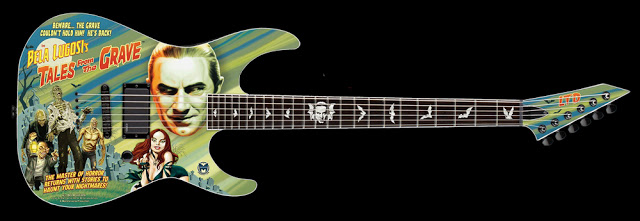 SP: …want that, but two, libraries buy collected copies. And we’ve had people tell us, you know, that they don’t make as much money off of comics…even our book is double sized, 52 pages, no ads, $4.99, and House of…what was it? HOUSE OF SECRETS came out a year ago on Halloween, same price, same amount of pages, but you get 13 pages of ads in it. You know? Versus we give you 13 pages of art, story, text, you know, and all these things. It’s a good deal. But the collected versions will sell to libraries and, I think, collectors now have kinda gotten into that mindset. I know I saw a lot of letters online and in, I mean, I study where they talk about comics and what they’re getting and a lot of people are saying, “I buy the individual issues digitally and then I buy the collected trade paperback or hardbound or something like that to keep to pull out for that wonderful experience of that.” And I’ll say one last thing that I love about print, and that is the page layout…when you look at Jack Kirby or Neil Adams or you look at any…or Paul Gulacy or anybody like that, there’s a beauty to the page layout and how your eye is moved across the page. And the real geniuses, the people that are fantastic about it, of which my cousin Kerry Gammill is…
SP: …want that, but two, libraries buy collected copies. And we’ve had people tell us, you know, that they don’t make as much money off of comics…even our book is double sized, 52 pages, no ads, $4.99, and House of…what was it? HOUSE OF SECRETS came out a year ago on Halloween, same price, same amount of pages, but you get 13 pages of ads in it. You know? Versus we give you 13 pages of art, story, text, you know, and all these things. It’s a good deal. But the collected versions will sell to libraries and, I think, collectors now have kinda gotten into that mindset. I know I saw a lot of letters online and in, I mean, I study where they talk about comics and what they’re getting and a lot of people are saying, “I buy the individual issues digitally and then I buy the collected trade paperback or hardbound or something like that to keep to pull out for that wonderful experience of that.” And I’ll say one last thing that I love about print, and that is the page layout…when you look at Jack Kirby or Neil Adams or you look at any…or Paul Gulacy or anybody like that, there’s a beauty to the page layout and how your eye is moved across the page. And the real geniuses, the people that are fantastic about it, of which my cousin Kerry Gammill is…superhero: You don’t have to convince me.
SP: I know, but I love saying it every chance I can--is that there’s something amazing about that on a printed page where the digital and on a monitor, the way it’s contained is not so…in the same form. You’ve still got a monitor and everything around your desk. You’re not holding a book looking at it, you’re not having light reflected off the page with the way that reflection of colors and the nuance and detail and everything that goes with that where you have light coming out of a screen, it’s just a different experience. And plus, if so many people get their things broken down on their iPhones and things like this panel by panel and all that, I mean, it’s a whole different art. And what I see in a lot of comics now is they’re trying to jump into digital but come out with a printed version and it’s lost a little bit of the design beauty these books had up until recently.
superhero: Yeah, true. What is your opinion on that, Kerry? Did I lose you?
KG: …I woke up. I never considered originally just doing a digital version because it just wouldn’t be a comic book to me that way. I wanted to at least start out in print and see how it would do selling in stores and we didn’t really know much about what the cost was going to end up being. It’s just something that felt right and we wanted to do it. Plus, I think it would’ve been harder to convince the Lugosi family to let us license the thing for a comic book if there wasn’t gonna be a real comic book. It’s been one of the difficulties…Bela, Jr., I guess he’s in his 70s now, he doesn’t understand anything about comics and how the business works. And so a lot of it has been us educating him on the comic business and especially today’s comic business and all the details of that, how it works, how long it takes to get something out, and how it’s solicited and ordered and all that. So we’ve had to kind of educate them on this. But yeah, we just wanted a real comic book you could hold in your hand and be like an old EC or Creepy comic. Is that gonna be the way of the future? Are people gonna actually prefer reading them online or on some other device instead of having a printed comic book? We have some digital comics available, we have the first Lugosi issue, and so we’ve kind of seen how sales go on that and so we’re exploring that and deciding should we just go digitally for the first release and then do print for a collected edition? So we’re kind of open to that and it’s more immediate and everything if you can put them out digitally instead of waiting all that time and paying all the money to get them printed.
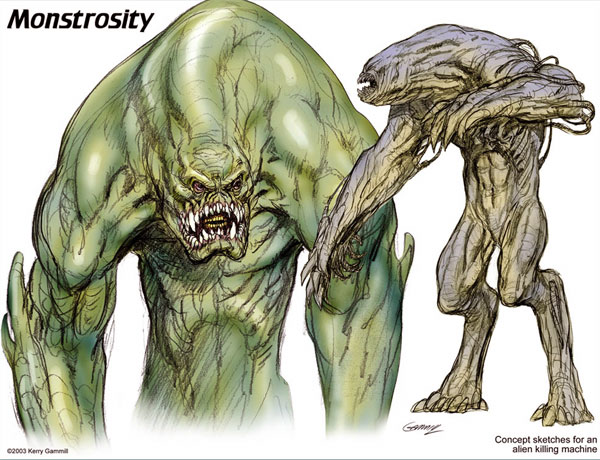 superhero: So digital editions possibly in the future?
superhero: So digital editions possibly in the future?SP: On iVerse Media we’ve got BELA LUGOSI’S TALES FROM THE GRAVE #1, and we will be also putting on that books we already have on Graphicly, which are BELA LUGOSI’S TALES FROM THE GRAVE #1 and we’ve got a book that Robert Tinnel, the writer of FLESH AND BLOOD, wrote with Ade Salmon and it’s called THE FACELESS. And it’s a great little story about a film director in the 60’s who made Hammer style-like movies, but gets involved with these occult murders and things and has these adventures. Then we have the Rondo Award winning book…and the Rondo Award is the top award for classic horror…
superhero: The Rondo Award?
SP: Yeah, it’s called the Rondo. It’s named for Rondo Hatton. And, by the way, Kerry sculpted the award of Rondo Hatton, the horror actor that was in a few movies. And so anytime anybody wins that, that little sculpture is by Kerry to show you his fingerprints are everywhere on everything.
So the book is called The Black Forest. It’s a black and white graphic novel and we have that available. And, get this, two graphic novel size books, ninety nine cents each, you got the Bela Lugosi book which is, you know, double size, fifty two pages, ninety nine cents, and we’ll be coming out with, in the next very soon, we’ll be coming out with the second issue of the Lugosi book will be available through those. And we’re talking to…oh, well, we’ve got two companies. We’ve signed with one and another, we just haven’t gotten product up yet. So, again, we’re expanding and getting into major companies to continue dealing with digital. We’ll have the Lugosi two up and we’re gonna take Flesh and Blood and we’re gonna work at offering issue one in four installments, break it up.
And then…and do the same with two as we move into coming out with three and these…and the other books that we have in development that we wanna put together. I’ll back up and say for a second, to go forward with this we’ve proven we can create comics that are high quality with the top people and all that. We’re now in a phase where we are working on raising the money to finance this expansion and all that. And to that end, I can let you know a little…I don’t think anybody…no one’s reported this yet, but we are discussing with the producer right now the possibility of doing Flesh and Blood as some sort of either film or TV series or something.
superhero: Oh, that would be awesome.
SP: I can’t tell you who or what, but I can tell you it’s a studio deal. So, we’ll…it’s just in the beginning to lay it out and all that, but we’re real excited and we think that’s gonna shine on Monsterverse as a company. And, again, back to raising money, doing things. And along with all this, we see even major companies using Kickstarter and things like that. When I mentioned releasing things digitally, we might do that and then turn around and say, “Ok, here’s this trade paperback, softbound, a hardbound, donate X amount of money you get this or that.” And we put it out like that.
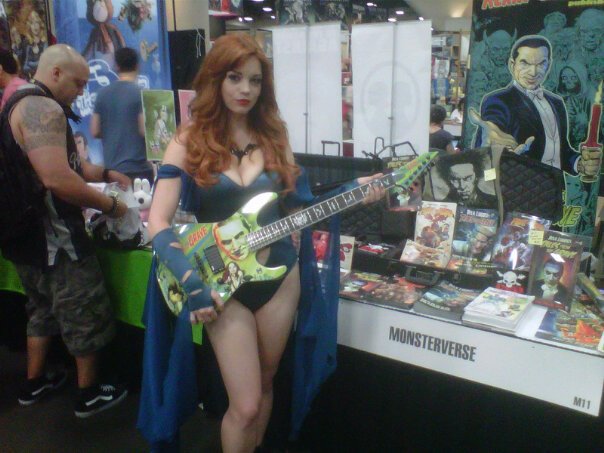 We’re exploring everything. You have to be if you’re a small publisher and working in today’s world. I can tell you, today I heard from a producer and he even sent me to a link for this Halo series or something online. And it was this digitally created series and they’re in bed with film on a couple of things, and these guys are major comic book fans. And they’re, you know, he was saying, “Would you…do you think Flesh and Blood and Monsterverse would work via this with something?” And I said, “Hell yeah!” There was interest. I mean, there’s people talking and they’re interested and horror continues to do well at the box office with all these different things. I’ve got a script that I wrote with the guys that did Paranormal… I mean, not Paranormal…THE POSSESSION. Styles White and Juliet Snowden. They also worked on KNOWING with Nick Cage and they did BOOGEYMAN for Sam Raimi, Ghosthouse Pictures, which THE POSSESSION was also one of theirs. That’s a script I’ve got with them. So we’ve got…there’s things happening all over and interest in Monsterverse in other media. Issue three will have a Steve Niles story that Kerry is illustrating.
We’re exploring everything. You have to be if you’re a small publisher and working in today’s world. I can tell you, today I heard from a producer and he even sent me to a link for this Halo series or something online. And it was this digitally created series and they’re in bed with film on a couple of things, and these guys are major comic book fans. And they’re, you know, he was saying, “Would you…do you think Flesh and Blood and Monsterverse would work via this with something?” And I said, “Hell yeah!” There was interest. I mean, there’s people talking and they’re interested and horror continues to do well at the box office with all these different things. I’ve got a script that I wrote with the guys that did Paranormal… I mean, not Paranormal…THE POSSESSION. Styles White and Juliet Snowden. They also worked on KNOWING with Nick Cage and they did BOOGEYMAN for Sam Raimi, Ghosthouse Pictures, which THE POSSESSION was also one of theirs. That’s a script I’ve got with them. So we’ve got…there’s things happening all over and interest in Monsterverse in other media. Issue three will have a Steve Niles story that Kerry is illustrating.We’ve got a couple of incredible stories illustrated by Hollywood conceptual artists. That’s another thing, we’re very well linked within the horror world. Here’s Rick Baker doing a cover for us, you know…but we’re friends…Kerry’s designed for like Greg Nicotero whose company does THE WALKING DEAD. And Greg’s now an executive producer for…I mean, I worked on a show, I think it was in 2003, for Bob Burns, it was the first Halloween show he’s done in 25 years based on THE THING FROM ANOTHER WORLD, the original movie. And Greg’s company supplied all the cool props and stuff and we built all these things. And, again, we bring all these people from film or comics and they wanna come and work on these books. So we’ve got these Hollywood conceptual artists that you will not believe the really cool stuff. Oh, and I wanna mention, we’ve got that ESP Bela Lugosi limited edition guitar coming out, which Kerry did the artwork and all that. You saw that.
superhero: Yeah, that thing is kick ass.
SP: All these, it’s real funny how once the company got started, Monsterverse, and they actually saw the books, then people began to come to us and do things or suggest Robert Tinnel and Neil Vokes with the wonderful FLESH AND BLOOD and these things. It’s so much fun, it’s a ton of work, and a lot of pain sometimes just dealing with everything. And Kerry, my God, Kerry is from his brain to his actual body loading up books and putting them in a trailer and bringing them out here to LA and back. But in the end, we feel when we hold these books and they just look so beautiful and people that are top guys turn around and say…we’ve got John Landis is doing a story for us. They just love it. And when you’re at something like Monsterpalooza and here’s Joe Dante saying, “I heard the book…Landis got a copy, where’s my copy?”
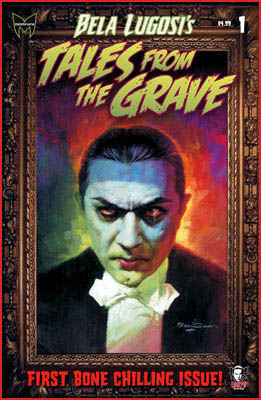 superhero: Well, your enthusiasm shines through.
superhero: Well, your enthusiasm shines through.SP: We just do backflips that they’re so happy and love it.
superhero: That’s great. Well, there’s a lot to love and I’ll definitely…whenever the third issue comes out, you’ve got to let me know so I can buy it. And I will pay for it because it’s worth it. It’s worth every penny.
SP: That’s the best compliment we could get!
superhero: Yeah, no. Absolutely. I know these things cost money.
KG: Other stuff we’ve got coming up, we found out that Bill Sienkiewicz had a few pages that he did for this…it had something to do with Vlad the Impaler, that was kind of the inspiration for Dracula. And it was a story done for a company that they never ended up printing it and they went out of business or something so he never got paid for it. So I’d been talking to him for about a year. Every time I’d see him at a convention I’d say, “Well, Bill, can we use those pages?” And he never was sure that the other guys were gonna come up with the money or not, so finally he said, “No, you can have them.” So we paid him a little bit for that. And it’s a beautiful story and what we’re gonna do is sort of make a fairy tale out of it. Bela Lugosi’s bedtime stories or something, and use this very beautiful…because it’s set in the Middle Ages, so it’s very fairy tale looking. So we’ll have some Sienkiewicz art in there. Sam’s been working on a couple stories with a guy named Henry Mayo who is one of the big storyboard artists. He was talking about these Hollywood people that we know, and so he wanted to do some stories for us.
SP: By the way, Henry colored all the Rocketeer books for Dave Stevens and worked with Dave getting all those books ready from issue two, just to give you an idea of how far he goes back.
KG: Comic stuff, most of it’s been in films. And Benton Jew, big storyboard artist, he’s doing some stuff. And I can’t think of any other…we’re doing one thing I’m working on also is a sequel to THE DEVIL BAT, one of Bela’s movies from the 40s. And it’s a very popular one of his Poverty Road movies, but it’s very well done for the budget and everything. So we’d thought it’d be fun to do the lost sequel to the thing. So it’s all being drawn in black and white; it looks like a Lugosi movie that you’ve never seen. And so those are the kinds of things we’re really having fun coming up with and trying stuff in there that’s very specific to Lugosi.
 superhero: Well, this all sounds great. I mean, is this for the third issue or just down the line?
superhero: Well, this all sounds great. I mean, is this for the third issue or just down the line?SP: Third and down the line. There’s the third issue we’re talking about here and other ones. We’ve got a think called “Dead Ringer” which is written by John Lansdale, who is Joe Lansdale’s brother who Joe works with and Joe Lansdale wrote BUBBA HO TEP and the books and a whole bunch of horror stuff. And Hank and I have a sort of a Lovecraft barbarian story that we’re doing for the book and we actually have a series of…to show you how we’re splitting off into some things, we’ve got something that’s an homage to Jack Kirby and to Lovecraft that’s gonna be action and wild monster crazy dimensional.
superhero: Yeah, that sounds right up…those are two great things that go great together I think, Lovecraft and Kirby! I think that would work.
SP: Oh, you’re gonna flip over…we’re really having a great time working this up. And we’ve got a guy named Lowell Isaac that you may not have seen his work, but he’s just got this cool, great, weird look to his stuff. It’s something called Evil Eye he’s doing for us. So we’re real excited. I wanna leave you with the fact that, yeah, there’s still things coming out in one form or another and we’ve got a lot of stories set up for the Lugosi book. And, of course, the incredible Robert Tinnel and Neil Vokes with the wonderful coloring by Matt Webb, FLESH AND BLOOD. If you really like how that thing’s been going, you will not believe when three hits.
superhero: Well, I’m gonna be picking that one up because I really do like Flesh and Blood as well. Well, that’s great. And I gotta say, I mean, I love the books, I’m real excited about Monsterverse and I just appreciate your guys’ time. I mean, I just appreciate you guys sitting down and just…like, at Comicon, Sam, you were just totally cool and really great to hang out with and I didn’t get to hang out with Kerry much, but still just being able to shake his hand. I was super happy.
Well, that’s it! Make super to check out everything Monsterverse related by clicking here! If you are a fan of old school, classic horror you will love BELA LUGOSI’S TALES FROM THE GRAVE and FLESH AND BLOOD!
Discovered as a babe in an abandoned comic book storage box and bitten by a radioactive comic fan when he was a teenager, superhero is actually not-so mild mannered sometime designer & cartoonist, Kristian Horn of Los Angeles, California. Some of his work can be seen at www.kristianhorn.com and check out his blog at www.parttimefanboy.com. You can check also out his webcomics at www.babybadass.com and thediplomatics.com, which is currently in development.
Proofs, co-edits & common sense provided by Sleazy G
